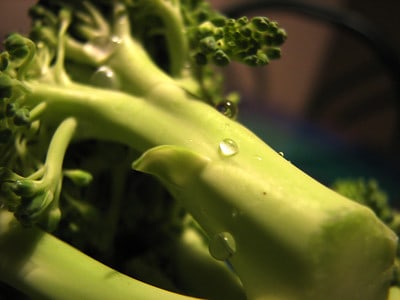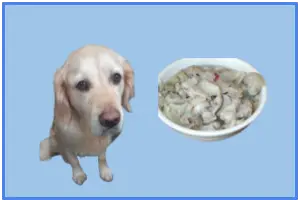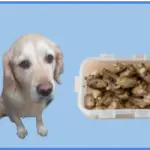
And now I return to one of my favourite topics- how to reduce waste!
It has always seemed a bit daft to me that, when it comes to the vegetables that we eat, large parts of them (such as the peelings) ends up in our compost bins and not on our plates.
Broccoli stems are a case in point- how much of those stems do we trim before we put the broccoli florets into the steamer.
An alternative to the trash or the compost bin could be our dogs.
So, if you feel that broccoli stalks are a bit too “woody” to chew, can they be fed to our dogs and in what nutrition will they provide?
I want to start with a quick comparison.
Broccoli stalks versus florets, which is more nutritious?
The florets are marginally more nutritious than the stems, although the ratio is very close.
The florets have fiber, which is surprisingly not found in the stalks.
Raw broccoli stems and florets have the same amount of potassium, iron and calcium.
Broccoli stems are rich in certain vitamins and minerals. How will this help my dog?
Like all mammals, dogs have need of various nutrients to stay healthy. Instead of wasting the stems, finding a way to feed it to your pooch is preferable.
Calcium helps your dog build and maintain strong bones.
Iron helps with red blood cell production and potassium plays several key roles in the health of your dog.
The trace amounts of vitamin D found in the stems will also help your dog’s overall need for that vital nutrient.
Dogs get some from the sun, but like most carnivores they don’t make enough.
Can my dog eat the stems raw?
Yes, if your dog will eat the stems raw.
If you wish to feed raw stems to a dog, you may have to grind them up first to mix them into his or her food. Our dog will put a stem into his mouth and then let it fall to the ground.
He’s not fond of carrots, either.
In some dogs, raw stems that aren’t ground up can be considered a choking hazard. It’s also important to keep the serving size ratio in mind.
A dog can have up to thirty percent of his or her food in plant form, but no more than that.
There are a couple of other ways to prepare broccoli stems for your dog. One, as mentioned, is to grind it up in the food processor.
However, after you grind it up, you can go ahead and make a fermented version. That will have the added benefit of helping promote gut health.
Can dogs eat broccoli leaves?
The question is once again, will the dog eat them, for they can.
Like the florets, the leaves have a large amount of fiber.
The same two preparation methods can be employed, if desired.
Can dogs eat cauliflower stems?
It isn’t recommended that dogs eat raw cauliflower, whether it’s a stem or a floret.
However, cooked cauliflower stems are not only healthy but nutritious.
While the two plants are related, they don’t have the same nutritional makeup.
Cauliflower has folate, which is a B vitamin.
Female dogs in an expectant state benefit because it helps with the formation of DNA.
The steamed stems also have vitamins C and K.
The former is good for immune health and the latter for bone formation.
There are texture differences with cauliflower, and that might make it easier to get a dog to eat it. If he or she isn’t impressed, it can be mixed with the regular dog food being served.
Why are asparagus stems so difficult for dogs to eat?
Eating raw asparagus can be difficult for dogs and humans.
Unless it is very fresh and harvested very early in the season, the stems are extremely woody. This makes chewing difficult and swallowing them a choking hazard.
This is especially true for small dogs.
Raw asparagus has a similar problem to that of raw cauliflower, but for a different reason.
Raw asparagus is harder for a dog to digest and could cause gas, vomiting and diarrhea.
For this reason, it is recommended that any asparagus meant for a dog be lightly steamed or boiled.
There is a third thing that can happen to your pooch, no matter whether or not the asparagus is cooked.
Humans have this same problem. It can change how urine smells and many people find this change to be very unpleasant.
Why should we feed our dogs the skins and peels from some fruits and vegetables?
The skin/peel of the plants we eat often has the lion’s share of the nutrients. Unless we have to peel them (think citrus fruit), it’s often best for us to eat the skins or peels.
When we can’t consume them ourselves, we can use some of them for our pets. A good example would be banana peels. While we would find it tough to eat them, they can be added to fermenting fruits and vegetables once they are ground up. Then both dogs and humans can consume them and reap the benefits.
What are some skins that we shouldn’t feed our dogs?
There are some peels your dog should not eat. While an occasional slip of potato peel won’t harm the dog, eating any type of potatoes on a regular basis can. They contain oxalates, which form crystals. The plants themselves also have solanine, which can poison your dog.
Avocados and their peels are also unhealthy for your dog. While the fruit tastes good for us and is full of nutrients, they are toxic to dogs. Grapes are also in the toxic category. The AKC has a list of some popular fruits and veggies, with an indicator of whether or not it’s safe.
Broccoli is rich in vitamin C, what other vegetables are rich in vitamin C?
The fleshy part of the cherry is a rich source of vitamin C. It’s best to pit them before giving them to your dog, as the pits contain cyanide. Orange peels may also be given to your dog and contain the vitamin.
Vegetables that are high in C include those found in the same family as broccoli. That means cabbage, cauliflower, Brussel sprouts and bok choy. Kale and collards are also high in the vitamin, but should only be given in small amounts.
Fermented broccoli stems
And now for something a little leftfield.
Instead of just feeding your dog raw or lightly steamed broccoli or stems that are cut into small chunks instead of being given as a whole, you can take your vegetable use a step further.
By making vegetable kimchi with it.
Kimchi is a fermented food which originated in Korea.
It uses cabbage and salt as a base.
Fermented foods are great because they contain healthy bacteria which aids a dog’s digestion.
And broccoli stalks (and cauliflower stems) would be a fine addition into this mix.
So, can dogs eat broccoli stems?
Yes, they can and they are a healthy way to use up vegetable scraps. They will help to keep your dog healthy and avoid filling landfills with perfectly good vegetation.
Because it may be difficult to get your dog to eat them, it may be necessary to chop them up small or use a food processor. This will prevent the dog from eating the food around the broccoli and leaving it in his or her bowl.
Don’t stop at broccoli stems…
There are many human foods dogs can eat in small amounts. They will help boost the dog’s health, immune system and keep the dog regular if that’s a problem. There are also some foods that we eat that dogs can’t.
Keep in mind that dogs, like humans, can have food allergies or intolerances. Some dogs may not be able to handle some of the constituents of broccoli or other foods, especially if they are garden fresh. A favorite family story is when I served my family cole slaw made from fresh cabbage. I loved it, but they thought they were being poisoned.
Dogs can have up to thirty percent of their diet in plant based foods. They are not obligate carnivores like cats, but they are also not exactly omnivores. They are classified as carnivores. Feeding them on a vegan diet would be detrimental to their health.
While cooking foods such as broccoli or cauliflower might make it easier to slip into a dog’s diet, the process also leaches out a lot of nutrients. They’re still good for your pet, but not as good. However, using them in a fermented form can make it easier and more nutritious for the animals.
Most dogs are personalities in their own right. They have opinions about many things and food is one of them. You may have to try different strategies to get your dog to eat some fruits and vegetables. While adding butter or bacon fat is one that would probably work, that isn’t a good idea for your pet. It’s as bad for them as it is for us.
When it comes to our pets, size matters. The amount of food our dog eats in one sitting would be two or three days’ worth for our younger daughter’s dogs. They are Chihuahuas and four nuggets of Oso’s food would be about equivalent to a big mac.
Before adding any new foods, check with your veterinarian. He or she will know your dog’s needs and help you choose wisely. The vet can also provide information about how much food to give and what ratio to use. Some dogs need more meat than others. A few have special needs that will preclude some vegetables.






